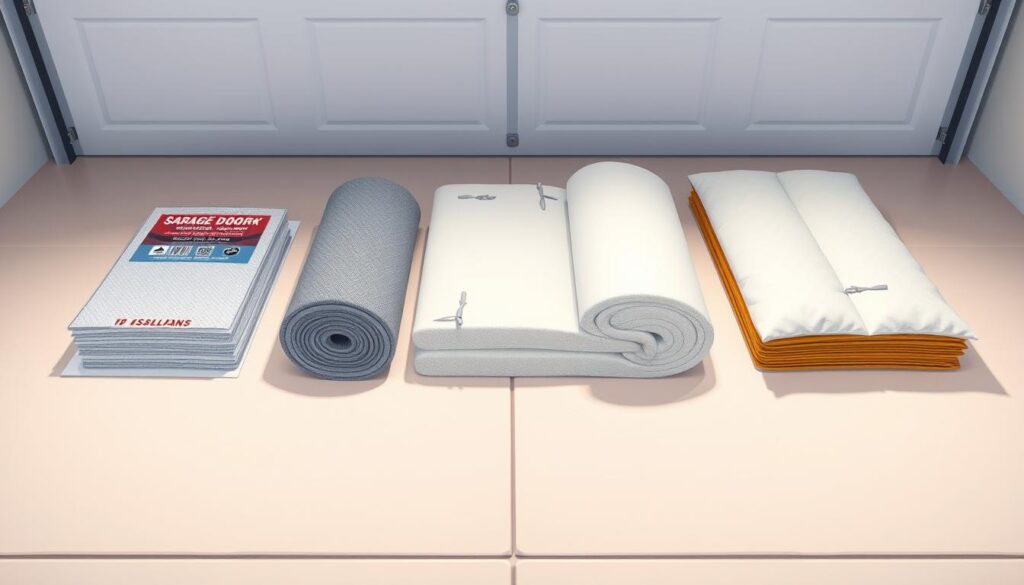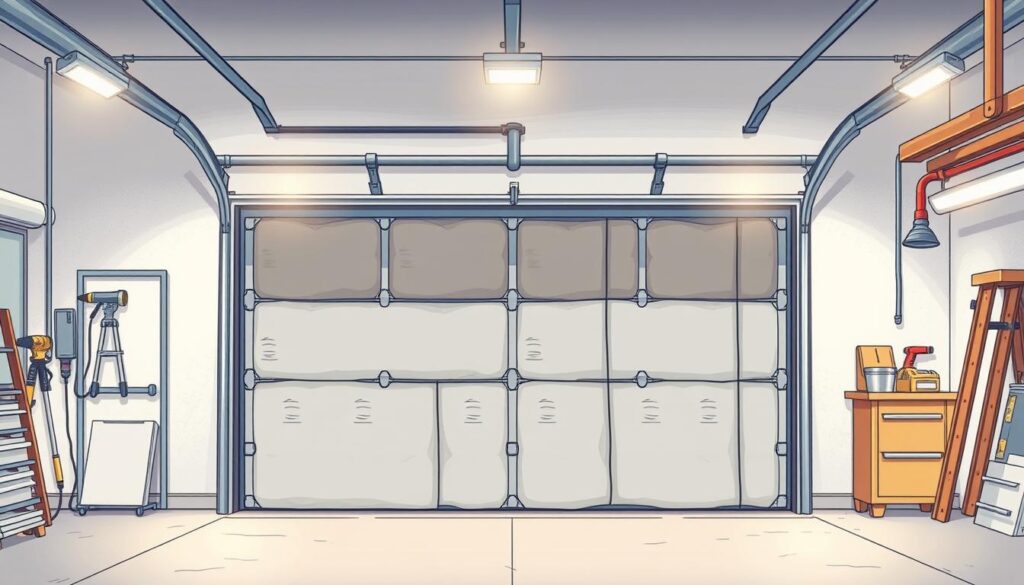Are you looking for the best garage door insulation kit? Insulation makes garages warm and cozy. We tested 5 top kits for a week.
Insulated doors kept the inside 8–10°F warmer in winter. This guide helps Moline, Illinois homeowners. It shows how to pick kits that save money and make homes comfy.
Garage door insulation kits cost $30–$130. But, the right one saves money in the long run. Our tests found US Energy Products and Matador are the best.
They balance performance and ease of use. Keep reading to find out how to pick a kit. It stops drafts, reduces noise, and makes your home more energy efficient.
Understanding the Importance of Garage Door Insulation
Garage doors let a lot of heat in and out. Energy efficient garage door insulation helps keep your home cozy. It saves money and lasts a long time.
Benefits of Insulated Garage Doors
- Keeps your workshop or gym at a steady temperature.
- Reduces how much your HVAC system works, saving up to 40% on bills.
- Thicker doors give you more room and block out noise.
Impact on Energy Efficiency
R-Value shows how well insulation works. Higher R-values mean better insulation. For example, polyurethane insulation is better than fiberglass.
| Material | R-Value | Key Features |
|---|---|---|
| Polyurethane | R-8 to R-10 | Blocks radiant heat, durable in extreme temps |
| Fiberglass | R-5 to R-6 | Affordable, resists moisture |
| Reflective Foil | R-4 to R-7 | Reflects heat, ideal for warm climates |
Noise Reduction and Security
Insulation can make your garage quieter by up to 60%. Thicker doors are harder to break into. Brands like Clopay’s Intellicore® offer strong, insulated doors.
Types of Garage Door Insulation Kits
Choosing the right garage door insulation is key. Each type has its own benefits. They vary in cost, R-value, and how easy they are to install.

Foam Board Insulation
Rigid foam boards and spray foam are great for insulation. They are light and easy to cut. The Kraken Bond FastCoat Spray Foam Kit gives R-7 per inch and comes in 12 cans for big areas.
The Cellofoam Garage Door Insulation Kit costs about $74. It fits doors up to 9 feet wide. These are good for cold places and make doors stronger.
Fiberglass Insulation
Fiberglass batts keep heat out well. The Owens Corning Garage Door Kit has R-8 and installs fast. It’s great for keeping attics and walls warm too.
It’s a good mix of keeping warm and being affordable.
Reflective Radiant Barrier
Reflective barriers like the Reach Barrier Reflective Kit ($48.28) stop heat from coming in. The US Energy NASATech Kit (R-8, $117.76) reflects 90% of heat. They’re good for hot places but might need more for cold.
- Price range: $48–$250
- R-values span 4–20+ based on material
- Fire-resistant options exist for garages with tools or machinery
Look at these options based on your climate, budget, and door size. Rigid foam is best for cold, while radiant barriers help in summer.
How to Choose the Best Garage Door Insulation Kit
Choosing the right insulation kit is about matching your needs to the top rated insulation for garage doors. Places like Moline face extreme weather. You need materials that handle both heat and cold well. Here’s how to find the right fit for your space and budget.
Factors to Consider
- Climate: In harsh winters, kits like the US Energy NASATech (R-8) keep cold and heat out.
- Usage: For workshops or home gyms, choose kits with higher R-values. The Kraken Bond spray foam (R-7 per inch) is great for these spaces.
- Budget: Look at prices: Cellofoam ($74) and Owens Corning ($118). Find the best value for your money.
“R-values above 6 are ideal for northern climates, while southern regions can prioritize radiant barriers,” says the U.S. Department of Energy.
Measuring Your Garage Door
Get accurate measurements to avoid buying too much. Measure height and width, including panel thickness. Also, check for windows. The Cellofoam kit’s 20-inch panels fit standard doors under 7ft tall. Double garage owners should check if kits like US Energy NASATech (fits 18ft widths) cover their space.
Evaluating R-Value Ratings
R-values show how well insulation works. A Kraken Bond kit with R-7 per inch keeps cold out better than Cellofoam (R-4.8). In cold states, aim for R-13+ by layering kits. Southern users might prefer Heat Wave Pro™ to reduce summer heat without needing high R-values.
Installation Process of Garage Door Insulation Kits

Follow this guide to install garage door insulation smoothly. First, get all the tools and materials ready. This will help you avoid delays.
Tools You’ll Need
- Measuring tape and utility knife
- Safety gear: gloves, safety glasses, and dust mask
- Adhesives like double-sided tape or foam sealant
- Cutters for trimming foam or fiberglass
- Retaining pins or clips for securing panels
Step-by-Step Installation Guide
Start by cleaning the door well. Measure each panel and cut insulation pieces 1-2 inches longer. For metal doors, use adhesive squares to align foam boards.
Fiberglass batts need clips. Check door movement after each panel to find any problems early. Owens Corning’s R-8 rated foam is better than standard kits.
Use foil tape to seal edges. Do this for all panels, making sure everything is stuck well before you’re done.
Common Mistakes to Avoid
- Skipping surface cleaning leads to poor adhesion
- Over-tightening fasteners can warp door panels
- Ignoring R-value guidelines for door type (e.g., heated garages need R-10+)
- Forcing misaligned panels risks warping or door malfunction
Adhesives in DIY kits stick forever, so place them carefully. Always check the door works right after each step to avoid big mistakes.
Cost Analysis of Garage Door Insulation Kits
Looking for affordable garage door insulation? First, you need to know about prices. Prices change based on what you choose. Here’s what you should know:
Price Ranges for Materials
- Foam board kits: $30–$130
- Fiberglass insulation: $100
- Professional installation: $100–$500 labor
Steel doors cost $600–$3,500. Wood doors can be up to $4,600. For a small budget, DIY fiberglass or foam boards are good. See this analysis for more cost details.
DIY vs. Professional Costs
Doing it yourself saves money. You can spend $350 on materials. But, professional labor can cost up to $4,500. Professional help might save time but increase costs.
Long-Term Savings
Investing in insulation now saves money later. Materials like polyurethane (R-12–R-18) keep heat out. This lowers your energy bills every year. Over time, affordable garage door insulation can also make your door last longer.
Top Brands for Garage Door Insulation Kits
Choosing the right brand means getting durable, effective insulation. Here are the top picks, based on user and expert feedback.
Top brands focus on performance, like R-value and how easy they are to install. Let’s see how they compare:
- Reach Barrier 3009: It gets R-8 and is easy to set up. People like how well it blocks noise.
- US Energy NASATECH: Its panels reflect 90% of radiant heat. Experts say it’s one of the best.
- Matador SGDIK001: It’s affordable and has R-4.8. Users say it’s quick to install.
Overview of Leading Brands
Reach Barrier uses light materials to avoid damaging doors. US Energy has NASATECH kits that use NASA tech. They lower garage temps by 30°F in tests. Matador kits are easy for DIYers to use. Owens Corning has fiberglass that reaches R-8 but needs safety gear to install.
Brand Reputation and Reviews
Customers say Reach Barrier cuts noise from 96 dB to 80 dB. A US Energy buyer said:
Installed in 30 mins—kept my garage 20°F cooler in summer.
Tests show NASATECH’s foil reduces radiant heat by 97%.
Warranty and Customer Support
Reach Barrier has a 10-year warranty. US Energy kits have lifetime coverage for damage. Matador offers 5-year guarantees. Look at warranties to find the best for your needs.
Maintenance Tips for Insulated Garage Doors
Keeping your insulated garage doors in good shape is key. Regular care helps your DIY garage door insulation work well. It keeps drafts out and saves on energy. Here’s how to keep your doors running smoothly.
Cleaning and Upkeep
Wipe your doors with a damp cloth or mild soap once a month. This removes dust. Don’t use harsh cleaners that can damage the finish.
Check the seals and hinges every season. For fiberglass or foam, gently brush off dirt. Most DIY garage door insulation kits come with tools for small repairs.
Signs of Wear and Tear
Watch for sagging panels, warped edges, or cracks in the insulation. Moisture or mold means the insulation is failing. This includes reflective foil or fiberglass.
Look for gaps between panels or if the temperature control is off. A good door keeps the temperature 50–75°F different inside and out, depending on the insulation.
When to Replace Insulation Kits
Replace kits if they’re not as efficient as they used to be. Or if they’re damaged. For example, if your door’s temperature difference drops, it’s time for a new kit.
Insulation kits like Owens Corning R8 fiberglass or Mr. Fred’s method last 8–10 years with care. Replace them if panels bulge, warp, or won’t close right. This keeps your garage safe and energy-efficient.

